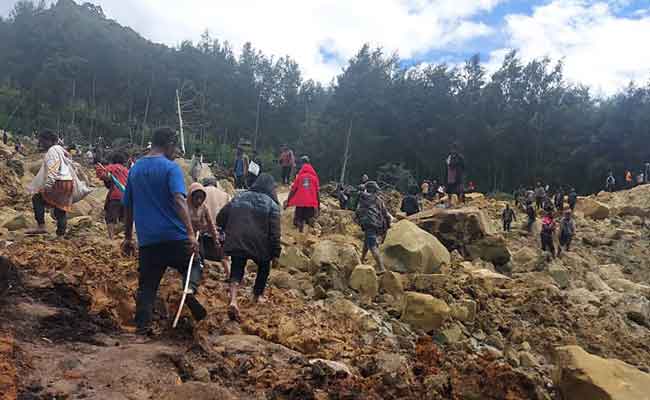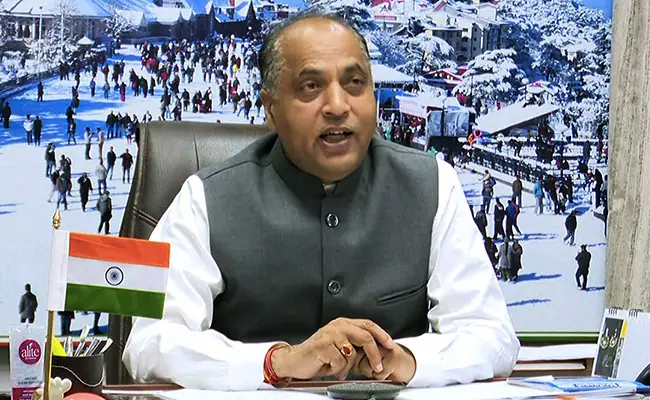Melbourne (AP): The Papua New Guinea government said a landslide on Friday buried more than 2,000 people and has formally asked for international help.
The government figure is around three times more than a United Nations' estimate of 670.
In a letter seen by The Associated Press to the United Nations resident coordinator dated Sunday, the acting director of the South Pacific island nation's National Disaster Center said the landslide “buried more than 2000 people alive” and caused “major destruction”.
Estimates of the casualties have varied widely since the disaster occurred, and it was not immediately clear how officials arrived the number of people affected.
Australia prepared on Monday to send aircraft and other equipment to help at the site of a deadly landslide in Papua New Guinea as overnight rains in the South Pacific nation's mountainous interior raised fears that the tons of rubble that buried hundreds of villagers could become dangerously unstable.
Australian Defence Minister Richard Marles said his officials have been talking with their Papua New Guinea counterparts since Friday, when a mountainside collapsed on Yambali village in Enga province, which the United Nations estimates killed 670 people. The remains of only six people had been recovered so far.
“The exact nature of the support that we do provide will play out over the coming days,” Marles told Australian Broadcasting Corp.
“We've got obviously airlift capacity to get people there. There may be other equipment that we can bring to bear in terms of the search and rescue and all of that we are talking through with PNG right now,” Marles added.
Papua New Guinea is Australia's nearest neighbour and the countries are developing closer defence ties as part of an Australian effort to counter China's growing influence in the region. Australia is also the most generous provider of foreign aid to its former colony, which became independent in 1975.
Heavy rain fell for two hours overnight in the provincial capital of Wabag, 60 kilometers (35 miles) from the devastated village. A weather report was not immediately available from Yambali, where communications are limited.
But emergency responders were concerned about the impact of rain on the already unstable mass of debris lying 6 to 8 metres (20 to 26 feet) deep over an area the size of three to four football fields.
An excavator donated by a local builder Sunday became the first piece of heavy earth-moving machinery brought in to help villagers who have been digging with shovels and farming tools to find bodies. Working around the still-shifting debris is treacherous.
Serhan Aktoprak, the chief of the International Organisation for Migration's mission in Papua New Guinea, said water was seeping between the debris and the earth below, increasing the risk of a further landslide.
He did not expect to learn the weather conditions at Yambali until Monday afternoon.
“What really worries me personally very much is the weather, weather, weather,” Aktoprak said. “Because the land is still sliding. Rocks are falling,” he added.
Papua New Guinea's defense minister, Billy Joseph, and the government's National Disaster Center director, Laso Mana, flew on Sunday in an Australian military helicopter from the capital of Port Moresby to Yambali, 600 kilometers (370 miles) to the northwest, to gain a firsthand perspective of what is needed.
Mana's office posted a photo of him at Yambali handing a local official a check for 500,000 kina (USD 130,000) to buy emergency supplies for the 4,000 displaced survivors.
The purpose of the visit was to decide whether Papua New Guinea's government needed to officially request more international support.
Earth-moving equipment used by Papua New Guinea's military was being transported to the disaster scene 400 kilometers (250 miles) from the east coast city of Lae.
Traumatised villagers are divided over whether heavy machinery should be allowed to dig up and potentially further damage the bodies of their buried relatives, officials said.
Let the Truth be known. If you read VB and like VB, please be a VB Supporter and Help us deliver the Truth to one and all.
Visakhapatnam (PTI): Shafali Verma hit a blistering unbeaten 69 as India made short work of a paltry target to outclass Sri Lanka by seven wickets in the second Women’s T20 International here on Tuesday.
India now lead the five-match series 2-0 after another one-sided victory, having restricted Sri Lanka to a modest 128 for 9 through a collective display of disciplined bowling from the spin trio of seasoned Sneh Rana, ably complemented by young spinners Vaishnavi Sharma and Shree Charani.
During the chase, vice-captain Smriti Mandhana (14) fell cheaply but Shafali, enjoying new found confidence after a stellar show in the World Cup final, sent the bowlers on a leather-hunt during her 34-ball knock, winning it for her team in just 11.5 overs.
The hosts have now completed back-to-back successful chases within 15 overs which speaks volumes about the unit's sky-high confidence.
Shafali's innings had 11 punchy boundaries apart from a maximum.
The floodgates opened when left-arm spinner Inoka Ranaweera bowled a few flighted deliveries and Shafali would step out everytime to hit her over extra cover. Her footwork against slow bowlers was immaculate whether stepping out to loft the ball or rocking back to punch or pull.
Seeing her confidence, the newly appointed Delhi Capitals skipper Jemimah Rodrigues (26 off 15 balls) also attacked as the duo added 58 runs in just 4.3 overs.
By the time Rodrigues was out trying to hit one six too many, the match as a contest was over. Shafali completed her half-century off just 27 balls and completed the formalities in a jiffy.
Earlier, off-spinner Rana, who got a look-in after Deepti Sharma was ruled out due to fever, showed her utility keeping the Lankan batters under tight leash with figures of 1 for 11 in 4 overs, including a maiden which certainly is a rarity in T20 cricket.
Charani, who made an impression during India's ODI World Cup triumph, took 2 for 23 in her quota of overs, while Vaishnavi after an impressive debut in the opening encounter, finished with 2 for 32, not letting the Islanders get easy runs in her second spell.
The last six wickets fell for just 24 runs, but what stood out during India’s bowling effort was their superb ground fielding. After a patchy show in the previous game, the improved sharpness in the field resulted in three run-outs.
Sri Lankan skipper Chamari Athapaththu (31 off 24 balls) looked in good nick as she deposited length deliveries from seamers Kranti Gaud and Arundhati Reddy over the ropes but it was Rana, who kept her quiet by repeatedly pitching on good length.
Unable to manoeuvre the strike and with the big hits suddenly drying up, Athapaththu chanced her arm at another delivery in which Rana had shortened the length slightly.
Not having transferred the weight into the lofted shot, Athapaththu's hoick was pouched cleanly by Amanjot Kaur at long-off.
This was after Athapaththu's opening partner Vishmi Gunaratne (1) had offered a simple return catch to Gaud.
Hasini Perera (22 off 28 balls) and Harshitha Samarawickrama (33 off 32 balls) did stitch a stand of 44 but they could never set the tempo against the Indian spin troika.
Once Hasini offered a tame return catch off a Charani full-toss, Sri Lankans never recovered and lost wickets in a heap towards the end.





